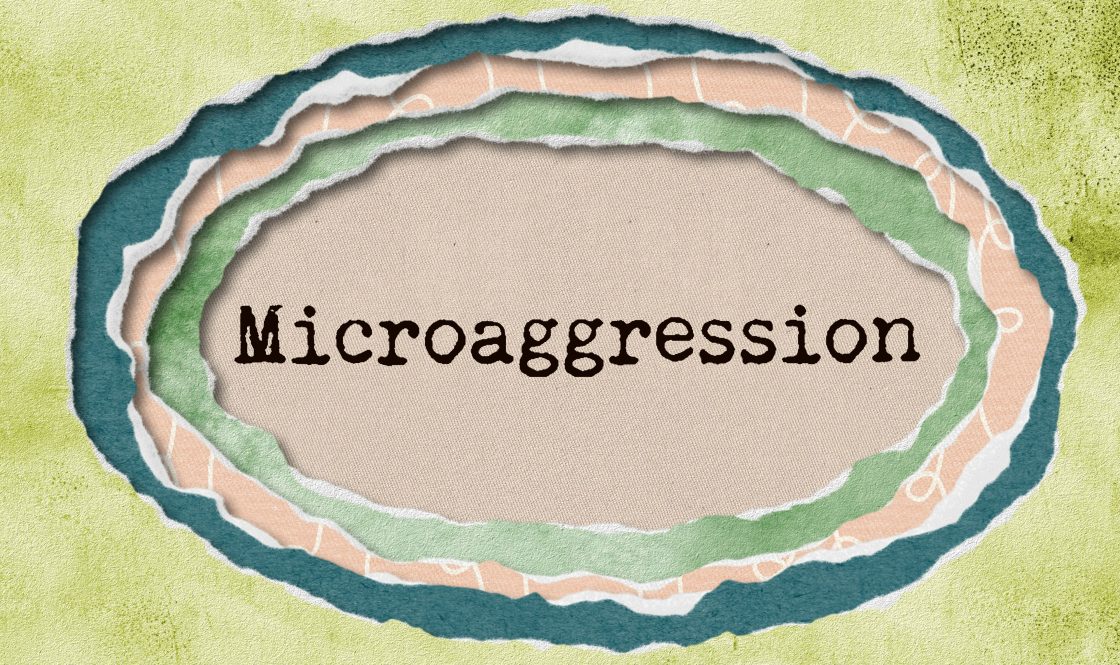Some microaggressions are subtle, possibly unintentional – a look, a gesture, invoking a stereotype, offering a comment that makes another person feel uncomfortable, unwelcome, or inferior.
Other microaggressions are more overt – using a slur, insulting a person’s ethnicity or appearance, telling them to “go back to where they came from.”
Though they show up in a variety of ways, the impact of racial microaggressions – interpersonal interactions defined by researchers as “commonplace verbal or behavioral indignities, whether intentional or unintentional, which communicate hostile, derogatory, or negative racial slights and insults” – is the same. Studies link racial discrimination to indicators of compromised psychological well-being, including depression, anxiety, suicide, low self-esteem, other psychiatric symptoms, and physical health symptoms.
And racial microaggressions occur everywhere – including on campus at UConn.
“I’m a sophomore here, and the amount of times I’ve been referred to as the N-word by non-black individuals is ridiculous.”
“I was approached by a young man and told to ‘Jump back over the border.’”
“Since coming to UConn, I’ve been asked why I ‘talk white’ or ‘don’t act black’ a number of times.”
Modeled after a survey project conducted at the University of Illinois, Urbana-Champaign, the 2020 UConn Microaggressions Survey sought to learn through both quantitative and open-ended questions about instances of racial microaggression that students of color experienced on UConn campuses and about the impact of those experiences on their mental and physical well-being and their sense of belonging. Conducted online between spring 2019 and winter 2020, a total of 1229 students of color at UConn participated in the survey.
The UConn survey team was led by Eleanor Shoreman-Ouimet, Assistant Professor of Anthropology; Annamaria Csizmadia, Associate Professor of Human Development & Family Sciences; Terence H. W. Ching, a clinical psychology doctoral student in the Department of Psychological Studies; and Micah D. Heumann, assistant director of the Academic Center for Exploratory Students, or ACES.
Ching explained that the project grew from a shared, interdisciplinary interest between researchers in the experience of oppression that students of color endure on the UConn campus.
“We wanted to understand how students of color experience and cope with the effects of racial microaggressions on campus, but also to represent their experiences in their own words,” says Ching. “And that was really the heart of this study – to name the problem, and to bring it to light, and to elicit some action from higher management.”
“It was truly interdisciplinary,” says Shoreman-Ouimet. “If you really want to solve a tough problem, you need lots of different people with lots of different backgrounds and lots of different ways of thinking in order to really create something that is going to be effective.”
“The time a professor pointed at me and asked if I was a U.S. citizen was the most insulted I have felt on this campus.”
“I’ve had professors make me feel like I wasn’t valuable to a classroom.”
“I was so upset by his comments that I couldn’t concentrate on his lectures.”
“The core finding is that racial microaggression is a real phenomenon on campus,” says Ching, “and it has real detrimental effects on students’ feelings of belongingness as well as their mental well-being.”
Forty-five percent of students of color who completed the online survey reported that race relations on campus were “somewhat to extremely problematic.” The two campus settings where the largest number of students of color reported feeling uncomfortable, or that they reported avoiding, were fraternity and sorority houses and classrooms.
“’Concerning’ doesn’t feel adequate to describe the impact,” says Csizmadia, who studies ethnic-racial minority youth development and identity and is the lead author of the Microaggressions Survey report. “And because 70 percent of the students of color who completed our survey were at the Storrs campus, we can conclude that the majority of these experiences are happening in Storrs.”
Students of color reported most frequently experiencing racial microassaults – being targets of offensive jokes or racial slurs – and racial microinsults – being made to feel intellectually inferior and not being taken as seriously because of their race. More than 40 percent of those surveyed reported racial microaggressions related to their intelligence and educational and academic goals.
About half of those surveyed reported feeling isolated on campus because of their race, and more than 40 percent felt they needed to minimize elements of their racial or ethnic identity to fit in on campus. They often found themselves to be the only student of color in their classes, and they experienced racial microaggressions not just from their peers, but from faculty and staff as well.
“These microaggressions are pervasive in the sense that they were reported in the learning environments – the classrooms – but also in the residence halls, and for me that’s really concerning, not just as a scholar of child, and youth development, but also as a parent,” Csizmadia says. “What that amounts to is young people, away from home, finding no safe space.”
“Putting yourself in that person’s shoes,” says Heumann, “that they go to class, they don’t feel welcome, they feel ridiculed, they feel called out for the color of their skin. And then you go to your home, where you’re living, and the same thing happens. Where do you go to get a break?”
The surveyed students also reported a lack of confidence that the University would respond appropriately to instances of discrimination, and a lack of familiarity with how to report incidents that occurred on campus. While students reported various methods of coping with racial microaggressions – talking with friends, seeking out family support, and attempting to avoid or limit exposure to incidences – very few reported making use of formal or institutional resources, like mental health services or other campus resources.
“While we observe considerable utilization of informal ways of coping with racial microaggressions among our students of color across the different broad racial groups, there is actually somewhat concerningly low rates of utilization of formal sources of support,” says Ching, who notes that students have access to a variety of services on campus – including services by clinical psychology doctoral students like himself – but students might not know those services exist or know how to access them.
“The nurse said something along the lines of ‘they all do this, change their names and pretend not to be Asian.’”
“I have been asked to return back to China on more than one occasion on the Storrs campus.”
“As an Asian American, I try to avoid clothes or behaviors that might make me seem like an international student because of the bias against them.”
Of particular note, the researchers said, were the reported experiences of Asian and Asian American students on campus. Twenty-eight percent of respondents identified as Asian or Asian American.
“One of the most alarming trends that came out of the report was the extremely high number of Asian and Asian American students at UConn who completed the survey and indicated the extent to which they are victims of very blatant microaggressions, racial assaults and insults, frequently in the classroom, in the dorms, in the dining halls, at various offices on campus, and this all predates COVID,” says Shoreman-Ouimet. “The students’ statements conveyed the sense that they were treated as a homogeneous group, and it conveyed a sense that they felt that they were still the accepted category to discriminate against. And that, to me, really raised serious alarms.”
While the survey was conducted prior to the coronavirus pandemic, the finding stood out to research team members in the midst of growing public consciousness in the country over incidents of violence and discrimination directed toward Asian Americans, Csizmadia noted.
“The largest group that filled out the survey were Asian and Asian American students, and so that’s particularly poignant in the context of what’s happening in the country,” she says.
“This has been an ongoing issue, and it’s gotten worse during COVID, but it didn’t start during COVID, and it’s something that we need to take a serious look at,” says Shoreman-Ouimet. “This University prides itself on its international diversity and its international profile, and we have to recognize the environment that we’re welcoming people into and the toll that it can take on these individuals.”
“I was asked to straighten my hair for it to look more presentable. It made me feel like my natural hair wasn’t beautiful. Last semester, I told them that I was not comfortable conforming to their ideals.”
“I would like to explore and meet new people but typically I haven’t been welcomed by non-people of color and heteronormative folk.”
“There are many groups of people that I avoid for I know they don’t understand people of my ethnicity. However, even people who I believe understand racial differences and are ‘woke’ do say things and act in racially insensitive ways and take offense when I do speak up about it.”
The researchers have presented the findings of the survey to various administrators at UConn, but are quick to say that they don’t have the answers on how to solve the problem of racial microaggressions and discrimination on campus.
“What I’m sensing as part of the team that presents this information is that we are looked at as the experts, in this sense, because we did the research,” says Ching. “But really, we don’t know all the things that go into the administrative process of how a university is run on a day-to-day basis. What we do want to acknowledge is, sometimes when culturally sensitive topics like this emerge in discussion, especially in a very professional large group setting, it can be hard to get past those initial feelings of defensiveness, perhaps. And I think, as we continue to have these conversations, my hope is for that defensiveness – for people to get used to that and to get past that so that we can use this information for the greater good of the campus community.”
Shoreman-Ouimet agrees, adding that the reception from administrators and other campus leaders thus far has been positive.
“We recognize that we have the benefit and the privilege of sharing student stories that they were bold and brave enough to share,” she says, “and the administration bears the burden of answering for it. That said, the administration and the various departments and entities that we’ve spoken to have been extremely supportive and welcoming of information and data. And we’ve made it very clear that this study was conducted with the intention of providing data so that we could target the areas that need assistance ASAP.”
“The report provides a compelling depiction of the microaggressive encounters that make it challenging for racially minoritized students to experience an institutional environment that is inclusive, affirming and equitable,” says UConn Vice President and Chief Diversity Officer Franklin A. Tuitt. “Though framed as ‘microaggressions,’ these racial assaults, slights, and invalidations should not be minimized, as frequent encounters can have a cumulative effect on our BIPOC student’s sense of belonging and overall academic experience.”
Tuitt continues, “The Office for Diversity and Inclusion, in collaboration with Provost Office and CETL, will continue to work with faculty and staff across the institution to build our collective capacity to mitigate the negative impact of microaggressions. We encourage all who want to learn more about how to create inclusive learning environments where all students but especially our BIPOC students have a chance to achieve at highest levels to explore the following resources: https://cetl.uconn.edu/resources/equity-minded-teaching/.”
The research team would like to see the survey funded and conducted each year as an annual climate survey to monitor incidences of racial discrimination on campus and to evaluate whether policies, outreach, and efforts to increase inclusion and equity on campus are working – and where they’re not.
“Change does take time, and one of the biggest barriers to change is not having sufficient information,” says Ching. “We envision this survey to serve as that source of information, to increase feelings of accountability so that at least we’re eliminating ones of reasons or one of the barriers for change.”
“We recognize, and certainly the administration is probably painfully aware, that culture change takes time and a lot of resources,” Csizmadia says. “We see the annual survey as something that would allow the administration to have the data to make very targeted interventions and to regularly assess if the University is indeed being successful in shifting culture.”
The report also notes several student recommendations to affect change at UConn, including more concerted efforts to celebrate diversity and cultural differences, increased diversity of faculty and staff, clarified and increased severity of the consequences of racist behavior, and increased training for member of the UConn community.
For Heumann, who notes there is a “false idea that diversity is the same thing as inclusion and equity,” change cannot come fast enough.
“This is a major issue,” he says. “There’s not going to be a silver bullet. We can’t just say, ‘oh, we just need a training to fix it. ‘ It’s got to be all-encompassing, and anytime there’s a conversation happening on this campus and diversity-equity-inclusion is not a part of that conversation, or a part of that program, then what we’re ultimately saying is that program is just for the dominant group, it’s just for the white students that have money on this campus.”
He continued, “And that is key to me and that’s something I really, really want to stress: Diversity-equity-inclusion has to be ingrained into every single aspect, and until it’s done, we’re not truly supporting all the students on this campus.”
Student quotes in this article were sourced from the 2020 UConn Racial Microaggressions Survey; the full survey report is available online at rms.research.uconn.edu.
The UConn Racial Microaggressions Survey team also included Monnica T. Williams, former associate professor with the Department of Psychological Sciences, now with the University of Ottawa; and research assistants Luz N. Burgos-Lopez, assistant dean of students; Justin P. Cohen ’20 (CLAS); Monique S. Cooper, PhD candidate, Educational Leadership; Alexandria McCormick ’22 (CLAS); Elizabeth A. N. Miller ’20 (CLAS); and Destiny Printz, PhD Candidate, Psychological Sciences.



